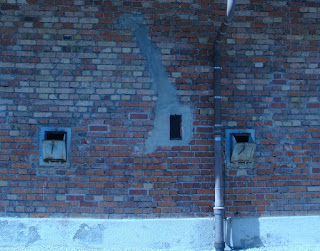Dachau was the site of the first of the concentration camps, opened in 1933 and intended for political prisoners, which is to say, those who opposed the Nazi regime. The burning of the Berlin Reichstag building in 27 February 1933 was used as an opportunity to introduce new laws which suspended civil liberties for Germans. Dachau was opened a few weeks afterwards.
Dachau was never an extermination camp. The Nazis kept those outside Germany. Yet, over 32,000 died at Dachau. Dachau was a prototypical business centre for the Nazi regime. A template for other camps and a source of income. Prisoners who were fit enough to work were employed within the camp or travelled to work in nearby factories. Companies such as BMW and Siemens all hired manpower at bargain prices in the form of those inmates who were fit enough, and suited enough, to the work.
Dachau’s ‘hospital’ was used for various experiments on prisoners. Tests on behalf of the Luftwaffe recorded the time a person, in normal flying gear, could survive in freezing water. Decompression experiments, where live prisoners were subject to abrupt pressure drops, were also carried out.
The euphemism, human resources was never applied so completely as at Dachau. The prisoners were exploited in every way imaginable. Once a prisoner had become too sick to work they were registered as ‘Invalid’ and then executed. In the doublethink logic of Dachau the ‘Invalids’ were deemed beyond rehabilitation. Everything possible was taken from them, each prisoner’s ‘medical’ record notes if they had gold fillings or crowns so that these could later be recovered from the bodies.
The brickwork of the crematorium at Dachau shows a roughness unlike typical German masonry. It was built by slave labour and quickly, and yet the design shows the usual attention to detail and efficiency.
Prisoners entered the building at one end via narrow rooms with overhead pipes where their clothes were hung. Soon, their clothes would be reused by others. Then they entered the ‘shower room’ and the door closed behind them.
This picture shows the exterior of the shower room. The chemical Zyklon B was poured into the cast iron chutes. Between the two chutes, the vertical rectangle, was an armoured glass panel where the condition of the prisoners could be monitored. Death could take up to twenty minutes. Afterwards a ventilation system cleared the room and the bodies were moved either to the ovens or to adjacent storage.
Many of us have some notion of prison life which includes a plucky group of prisoners outwitting the guards and maintaining a sense of dignity. This was not the case at Dachau. The administrators had planned for that and had a system which of all the things at Dachau strikes me has the most ingenious, and the most invidious.
The picture shows part of the Memorial of Badges, one of several artworks which are in place in the camp. These show the different markers that the prisoners wore on their uniforms. We all recognise the Star of David but there were many prisoner badges whih indicated a position within a catalogue of groups. The groups became a hierarchy of privilege and punishment.
The German hardened criminals wore green triangles. Red triangles were worn by the Communists, Social Democrats and other political prisoners, and blue by the foreign workers. Homosexuals wore pink triangles. There were Brown badges for the Gypsies and Jehovah's Witnesses wore a purple triangle. A bar over the top of the triangle meant that an inmate was a second-timer, or a prisoner who had served time in the camp, been released, and had then been arrested again. The Jews always wore two triangles with a yellow triangle on top of another colour, usually red which signified a political prisoner.
The hierarchy always placed the Jews at the bottom, with the gypsies immediately above them, and then raising, through some subtle league table, the other groups up to the most privileged and powerful, the green triangles - the hardened criminals. As a result everyone knew who they were and where they were in the pecking order.
With this ‘chain of command’ the SS, who ran the camp, were able to maintain discipline with the minimum of guards. Privileges, and extra rations were handed out to the people at the top of the prisoner hierarchy. These used their power to maintain order.
In the years after the war the camp at Dachau was used for emergency accomodation and with the post war rebuilding the Bavarian government came under pressure to clear the site. This was resisted and over the years the site has been reconstructed in certain areas in accordance with the photographs and the records the SS kept.
At the end Dachau is exactly what it was first intended to be, a showpiece for a regime. A regime which generated terror on an unprecedented scale.





No comments:
Post a Comment